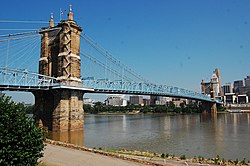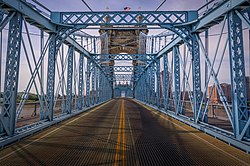
Back جسر رويبلنغ المعلق Arabic John A. Roebling Suspension Bridge German Puente colgante John A. Roebling Spanish Cincinnati-Covingtoni sild Estonian John A. Roebling zubi esekia Basque Roebling Hängebröck KSH 约翰·奥古斯都·罗布林吊桥 Chinese
John A. Roebling Suspension Bridge | |
|---|---|
 The bridge in 2009 | |
| Coordinates | 39°05′32″N 84°30′35″W / 39.0922°N 84.5096°W |
| Carries | |
| Crosses | Ohio River |
| Other name(s) | Covington and Cincinnati Suspension Bridge |
| Maintained by | Kentucky Transportation Cabinet[1] |
| Characteristics | |
| Total length | 1,642 ft 11 in (500.8 m)[2] |
| Longest span | 1,057 ft (322 m)[3] |
| Clearance below | 100 ft (30 m) in 1867. Current clearance at normal pool: 74 ft (23 m) [4] |
| Location | |
 | |
Covington and Cincinnati Suspension Bridge | |
 A view of the John A. Roebling Suspension Bridge from Cincinnati, Ohio on the north bank of the Ohio River with Covington, Kentucky in the background | |
| Location | Cincinnati, Ohio to Covington, Kentucky |
|---|---|
| Coordinates | 39°5′32.03″N 84°30′34.45″W / 39.0922306°N 84.5095694°W |
| Built | 1856—1867[6] |
| Architect | John A. Roebling |
| NRHP reference No. | 75000786[5] |
| Significant dates | |
| Added to NRHP | May 15, 1975 |
| Designated NHL | May 15, 1975 |
The John A. Roebling Suspension Bridge (formerly the Cincinnati-Covington Bridge) is a suspension bridge that spans the Ohio River between Cincinnati, Ohio, and Covington, Kentucky. When opened on December 1, 1866, it was the longest suspension bridge in the world at 1,057 feet (322 m) main span,[3] which was later overtaken by John A. Roebling's most famous design of the 1883 Brooklyn Bridge at 1,595.5 feet (486.3 m). Pedestrians use the bridge to get between the hotels, bars, restaurants, and parking lots in Northern Kentucky. The bar and restaurant district at the foot of the bridge on the Kentucky side is known as Roebling Point.
Ramps were constructed leading directly from the bridge to the Dixie Terminal building used for streetcars. These provided Covington–Cincinnati streetcars "with a grade-separated route to the center of downtown, and the terminal building was originally intended to connect, via underground pedestrian passages, with the never-built Fountain Square Station of the infamous Cincinnati Subway."[7] When streetcar service ceased in the 1950s, the terminal was converted to a diesel bus terminal. The ramps were removed in 1998 when it ceased being used as a bus terminal.[8]
- ^ "ArcGIS Web Application".
- ^ "Roebling Suspension Bridge I Finite Element Model and Free Vibration Response". Figure 2.
{{cite web}}: CS1 maint: others (link) - ^ a b Kenton County Public Library (August 1, 2003). Images of America: Covington, Kentucky. Arcadia Publishing. p. 9. ISBN 9780738515434. Retrieved May 7, 2013.
- ^ "Bridge Calculator, Midwest Region, Ohio River".
- ^ "National Register Information System". National Register of Historic Places. National Park Service. January 23, 2007.
- ^ Clarke, S. J. (1912). Cincinnati, the Queen City, 1788-1912. Vol. 2. The S. J. Clarke Publishing Company. p. 529. Retrieved May 20, 2013.
- ^ "John A. Roebling Cincinnati Suspension Bridge".
- ^ "DIXIE TERMINAL BUILDING - Cincinnati, Ohio - American Guide Series on". Waymarking.com. Retrieved August 26, 2011.
© MMXXIII Rich X Search. We shall prevail. All rights reserved. Rich X Search

